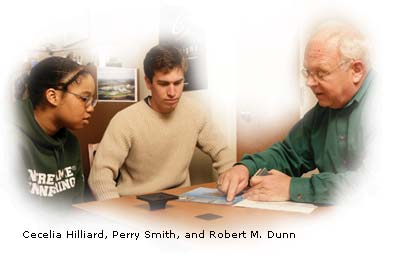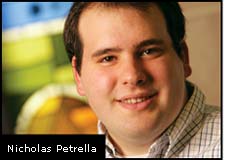

| The first time the Four
Horsemen "rode" was during the October 18, 1924, Army-Notre
Dame game, when the Fighting Irish routed Army. Immortalizing specific
players as the "Four Horsemen," Grantland Rice of the New
York Herald Tribune also called the Irish the "South Bend
cyclone," because of their speed and the way their offense would
shift before the defense could adjust. The team's agility, determination,
and focus amazed everyone. It was the beginning of a legend. So taking the name Four Horsemen Ventures was a bit of a challenge for the students, faculty, and alumni participating in the development of a high-tech entrepreneurial program within the College of Engineering, but it was one they welcomed. Entrepreneurial studies have been a topic in business schools for the last 20 years. In fact, more than 1,500 universities provide some form of entrepreneurial education. They offer business plan programs, leadership seminars, and student competitions primarily for business students and rarely for engineers. Only a handful of engineering schools offer entrepreneurial programs to their students. "There is a real need here ... and a real opportunity," says Robert M. Dunn, director of the Integrated Engineering and Business Practices program. "Engineers are problem solvers by nature; they create the technologies of tomorrow. Yet, what many young engineers lack as they enter the workplace is an understanding of the entrepreneurial process as it relates to technology. We're developing a high-tech entrepreneurial program at Notre Dame, because we believe that it will prove an important tool for our students, faculty, and alumni and that it has the potential to benefit society." The establishment of an entrepreneurial program and venture fund stemmed from a suggestion made by two alumni. Brothers Kevin G. and Timothy J. Connors, both graduates of the Department of Electrical Engineering and both venture capitalists, brought the idea of developing a entrepreneurial program for students to the college. They also provided the initial funding to make the program possible. Although the Connors brothers were already active with the University's Gigot Center for Entrepreneurial Studies through the Mendoza College of Business (MCOB), their suggestion hinged on the belief that engineering entrepreneurship is a different animal and requires a different approach than business entrepreneurship. The typical business approach is to identify a market need before developing a product. High-tech entrepreneurs start with a new idea and then search for markets in need of the product or process.  Intrigued by the concept and wishing to explore the benefits offered
via an entrepre-neurial program, Dean Frank
P. Incropera asked Dunn
to form a committee to study other universities involved in similar
programs and to make recommendations about the formation of a program.
Committee members were: John M. Brauer, associate director of the Integrated
Engineering and Business Practices program; Michael
T. Edwards, assistant
vice president and director of the University's Office of Research;
Curt Freeland, associate professional specialist in computer science
and engineering; Peter M. Kogge, the Ted H. McCourtney Professor of
Computer Science and Engineering; David
T. Leighton Jr., professor
of chemical and biomolecular engineering; Steven
R. Schmid, associate
professor of aerospace and mechanical engineering; Robert
L. Stevenson, professor of electrical engineering; and Wilasa
Vichit-Vadakan, the
Clare Booth Luce Assistant Professor of Civil Engineering and Geological
Sciences. Intrigued by the concept and wishing to explore the benefits offered
via an entrepre-neurial program, Dean Frank
P. Incropera asked Dunn
to form a committee to study other universities involved in similar
programs and to make recommendations about the formation of a program.
Committee members were: John M. Brauer, associate director of the Integrated
Engineering and Business Practices program; Michael
T. Edwards, assistant
vice president and director of the University's Office of Research;
Curt Freeland, associate professional specialist in computer science
and engineering; Peter M. Kogge, the Ted H. McCourtney Professor of
Computer Science and Engineering; David
T. Leighton Jr., professor
of chemical and biomolecular engineering; Steven
R. Schmid, associate
professor of aerospace and mechanical engineering; Robert
L. Stevenson, professor of electrical engineering; and Wilasa
Vichit-Vadakan, the
Clare Booth Luce Assistant Professor of Civil Engineering and Geological
Sciences.The committee identified 12 major activities common to the most successful programs and submitted a series of objectives and actions for implementation. According to the committee, the first and most important initiative would be the establishment of a student-run organization whose members -- undergraduate and graduate students, faculty, and alumni -- would meet a minimum of once a month to learn more about the process of vetting and capitalizing innovations. Members would also participate in the assessment of specific projects and commitments to venture funding. A total of 30 people attended the first meeting, which was held in December 2004. Among the attendees was Christopher Tilton, a senior majoring in mechanical engineering. Tilton, who has high hopes for the program, believes that the Four Horsemen will give students valuable information about what it means to be an entrepreneur. "Having attended all the meetings so far, I think it's going to be a great way to learn how to start a technology oriented business," he says. Entrepreneurial education was identified as another important aspect of a successful program. Although the college already offers a two-course sequence as part of its Integrated Engineering and Business Practices program, the committee recommended that the first course in the sequence, Fundamentals of Integrated Engineering and Business, be changed to include a segment on business plans, which had previously been offered in the second course, Advanced Integrated Engineering and Business. Originally open only to upperclass-men and graduate students, the initial course would be opened to sophomores, allowing them to become acquainted with the principles of venture funding earlier in their tenure at Notre Dame. Development of the Four Horsemen Venture Fund, was a third action outlined by the committee. Although there is a significant amount of work to be accomplished regarding the legal structure of the fund before operations can begin -- such as equity obligations, oversight rights and responsibilities, and technology ownership -- the committee is confident that an appropriate structure can be established and a venture fund operated to the benefit of participating students, faculty, and alumni. Few universities have profitable intellectual property portfolios because of the expenses associated with filing, marketing, and maintaining the patents. Nevertheless, committee members described the development and protection of intellectual property as one of the most important considerations in establishing a viable program. Provisional and filed patents, which would be owned by the University, would protect the new businesses and entrepreneurial activity in the fund. An area that the committee envisioned as immediately attainable was the development of summer internships. In order to stimulate interest in the college’s entrepreneurial enterprise and increase the educational experience of students, the college has been seeking internships for its students with start-up companies. Working with the University’s Career Center, as well as with representatives from the Kauffman Fund and the Lilly Foundation, the college expects to offer several such opportunities this summer.  A senior in the Department of Computer Science and Engineering, Nicholas
Petrella knows the benefit of an internship with a start-up company.
Before joining the Four Horsemen program, he interned with Medtuity,
Inc., a healthcare company located in Westerville, Ohio, that is developing
electronic medical records. "Not many engineering
programs provide a good overview of the business world," says
Petrella, "let alone a sense of the legal, financial, and operational
issues involved with running your own company. From my internship experience
and through the Four Horsemen program, I feel I'm gaining a better
understanding of the nuances and requirements of running my own business,
which is a goal of mine." A senior in the Department of Computer Science and Engineering, Nicholas
Petrella knows the benefit of an internship with a start-up company.
Before joining the Four Horsemen program, he interned with Medtuity,
Inc., a healthcare company located in Westerville, Ohio, that is developing
electronic medical records. "Not many engineering
programs provide a good overview of the business world," says
Petrella, "let alone a sense of the legal, financial, and operational
issues involved with running your own company. From my internship experience
and through the Four Horsemen program, I feel I'm gaining a better
understanding of the nuances and requirements of running my own business,
which is a goal of mine."Other initiatives identified by the committee include the formation of an advisory network, the recruitment of program participants, development of business plan competitions, creation of new business incubators, establishment of a distinguished leaders lecture series, creation of scholarships, and involvement in entrepreneurial conferences on and off-campus. Because the Four Horsemen is a new program, it is unlikely that all 12 activities will be implemented in the 2004-05 academic year, but the committee has targeted eight of them, setting specific goals for the year. "We're working to establish the program," says Dunn. Key needs in the coming year include the continued development of ideas for projects, establishment of a technical advisory board, and creation of a capital fund as a resource for the program and seed money for start-ups who meet the venture fund requirements. "This development stage is an exciting time in the program," says Timothy Connors. "Students have already started working with venture capitalists and successful entrepreneurs to write software for a commercial application. They are also working with MBA students from MCOB to develop business and marketing plans. But what is most exciting is that, as the students currently participating in the program become alumni, they can return to help the next generation of students, creating a cycle of learning and doing." If one subscribes to the adage, "Nothing ventured, nothing gained," it's easy to see the benefits of the Four Horsemen program: It exposes students and faculty to real-world problems and the entrepreneurial process, while introducing them to alumni with relevant experience and internship opportunities. Students benefit as they realize that they -- like the original horsemen -- must remain agile, determined, and focused on their goals. The college benefits from patent ownership and the leveraging of its strong alumni network. Alumni become more invested in the college, but they also benefit if their proposal or product is funded by the program. And, when Four Horsemen Ventures identifies and helps to fully develop products that raise the quality of life, society benefits. Although it is still too soon to tell, Four Horsemen Ventures may be another legend in the making. For information about Four Horsemen Ventures or to participate, contact Robert M. Dunn at dunn.47@nd.edu. |
|||||||||||||||
|
|||||||||||||||
|
|||||||||||||||
 Some legends are based
in truth, but the most important element of a legend is its longevity.
The original Four Horsemen of Notre Dame were (left to right, above)
Don Miller, right halfback; Elmer Layden, fullback; Jim Crowley,
left halfback; and Harry Stuhldreher, quarterback. Long after leaving
the University, they "rode again" in 1998 when the
U.S. Postal Service issued a series of stamps commemorating the
Roaring Twenties, part of its "Celebrate the Century" program.
Some legends are based
in truth, but the most important element of a legend is its longevity.
The original Four Horsemen of Notre Dame were (left to right, above)
Don Miller, right halfback; Elmer Layden, fullback; Jim Crowley,
left halfback; and Harry Stuhldreher, quarterback. Long after leaving
the University, they "rode again" in 1998 when the
U.S. Postal Service issued a series of stamps commemorating the
Roaring Twenties, part of its "Celebrate the Century" program. 



